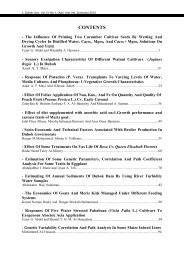Create successful ePaper yourself
Turn your PDF publications into a flip-book with our unique Google optimized e-Paper software.
J. Duhok Univ., Vol.14, No.1 (Pure and Eng. Sciences), Pp 30-38, 2011<br />
The mechanisms were by oxidative stress plays a<br />
role in the pathogenesis of HTN involve in both<br />
hemodynamic (vasoconstrictive) and structure<br />
mechanisms (Denu et al.,1998). Vitamin E or C<br />
which they represent as antioxidants, might be<br />
strengthen the ability of melatonin to reduce<br />
further degree of blood pressure. Melatonin can<br />
significantly lower plasma ET-1(Maulood,2005),<br />
it can also reduce serum total cholesterol and<br />
serum triacylglycerol (Nishida et al.,2002).<br />
Additionally, Sozmen et al., (1998) concluded<br />
that increased total cholesterol, triacylglycerol,<br />
low-density lipoprotein (LDL) and decreased<br />
high-density lipoprotein(HDL) values were<br />
found in patients with HTN. As mentioned<br />
previously, melatonin seems to interfere with<br />
peripheral and central autonomic system with<br />
subsequent decrease in the tone of adrenergic<br />
system and an increase in cholinergic system<br />
(Paulis and Simko,2007). Unlike other<br />
antioxidant, melatonin also does not undergo<br />
redox cycling; melatonin once oxidized can not<br />
be reduced to its former state because it forms<br />
several stable end products upon reacting with<br />
free radicals (Pechanova et al., 2006).<br />
Meanwhile, melatonin, vitamin C ,vitamin E and<br />
their combinations treatments caused the same<br />
degree of SBP reduction on the eighth and tenth<br />
week. One possible hypothesis is that long term<br />
administrations of these treatments might<br />
improve the hypertensive effects of lead<br />
exposure through normalizing NO levels as<br />
detected in the current results on the last<br />
week of treatments.<br />
Current study demonstrated that long-term<br />
lead administration significantly decreased<br />
serum calcium, this result may be due to reduces<br />
in sarcolemmal calcium influx (Vassalo et<br />
al.,2008). Furthermore, different considerations<br />
have been raised to explain the pathogenesis of<br />
lead-induced HTN, such as an increased<br />
intracellular calcium concentration (Khali-<br />
Manesh et al., 1993). However, vitamin E<br />
increased serum calcium , its combination with<br />
vitamin C reduced and returned it to the Pb<br />
group. This result is consist with Norazlina et<br />
al., (2004) presented that vitamin E deficiency<br />
caused hypocalcaemia during the first month of<br />
the treatment period, increased the parathyroid<br />
hormone level in the second month and<br />
decreased the bone calcium content in the 4th<br />
lumbar bone at the end of the treatment.<br />
Interestingly, vitamin C and E in combination<br />
returned serum calcium to normal values. The<br />
reason of this result may firmly related with<br />
vitamin C rather than vitamin E. Boaz et al<br />
.,(2005) concluded that vitamin C<br />
supplementation could prevent bone loss caused<br />
by chitosan through the increment of retained<br />
Ca +2 followed by suppression of urinary<br />
Ca +2 excretion.<br />
Melatonin and its combination with vitamin<br />
E and C decreased serum potassium significantly<br />
compared with Pb group. Maulood, (2005)<br />
found that melatonin decreased ET-1, thereby<br />
decreasing serum potassium level. However the<br />
evidence for direct action of melatonin on<br />
adrenal gland is highly conflicting in nocturnal<br />
rodents like rats (Reiter et al., 2008). Hurwitz et<br />
al., (2003) demonstrated that there was a diurnal<br />
variation of aldosterone and plasma renin<br />
activity in relation to melatonin, they reported<br />
that melatonin precedes aldosterone secretion<br />
independent on plasma renin activity, in turn<br />
increase the potassium excretion.<br />
There were no significant changes in body<br />
weight among the studied groups, however, on<br />
the last week of treatments, co-administration of<br />
melatonin and vitamin E slightly reduced body<br />
weight comparing with Pb group. This finding is<br />
confirmed by Liu and Huang (1996)who<br />
showed that, rats fed the vitamin E diet had<br />
significantly lower body weight gain and food<br />
intake than rats fed the vitamin E-deficient<br />
control diet. Additionally, it has been<br />
documented that melatonin reduced plasma<br />
leptin (Nishida et al., 2002). Thus, leptin serves<br />
a primary role as an anti-obesity hormone<br />
(Ahima and Flier,2000).<br />
In conclusion, long term lead-treated rats<br />
exhibited marked elevation of blood pressure<br />
and heart rate, significant reduction of serum NO<br />
and calcium levels. These abnormalities nearly<br />
disappeared with the antioxidants melatonin in<br />
combination with vitamin E or C more than<br />
vitamin E, C and their combinations.<br />
REFERENCES<br />
-Ahima, R.S.; Flier, J. S., (2000). Leptin. Annu. Rev.<br />
Physiol. 62:413–37<br />
-Attri, J; Dhawan, V; Mahmood, S; Pandhi, P; Parwana,<br />
H.K and Nath R.(2003): Effect of vitamin C<br />
supplementation on oxidative DNA damage in an<br />
experimental model of lead-induced hypertension.<br />
Ann Nutr Metab. ;47(6):294-301.<br />
-Badavi ,M; Mehrgerdi ,F.Z; Sarkaki ,A; Naseri, M.K,and<br />
Dianat, M.(2008) Effect of grape seed extract on<br />
lead induced hypertension and heart rate in rat. Pak<br />
J Biol Sci. 15;11(6):882-7.<br />
-Boaz ,M; Weinstein ,T; Matas, Z; Green, Smetana<br />
.S(2005): Peripheral vascular disease and serum<br />
phosphorus in hemodialysis: a nested case-control<br />
study. Nephrol. 63(2):98-105.<br />
03



